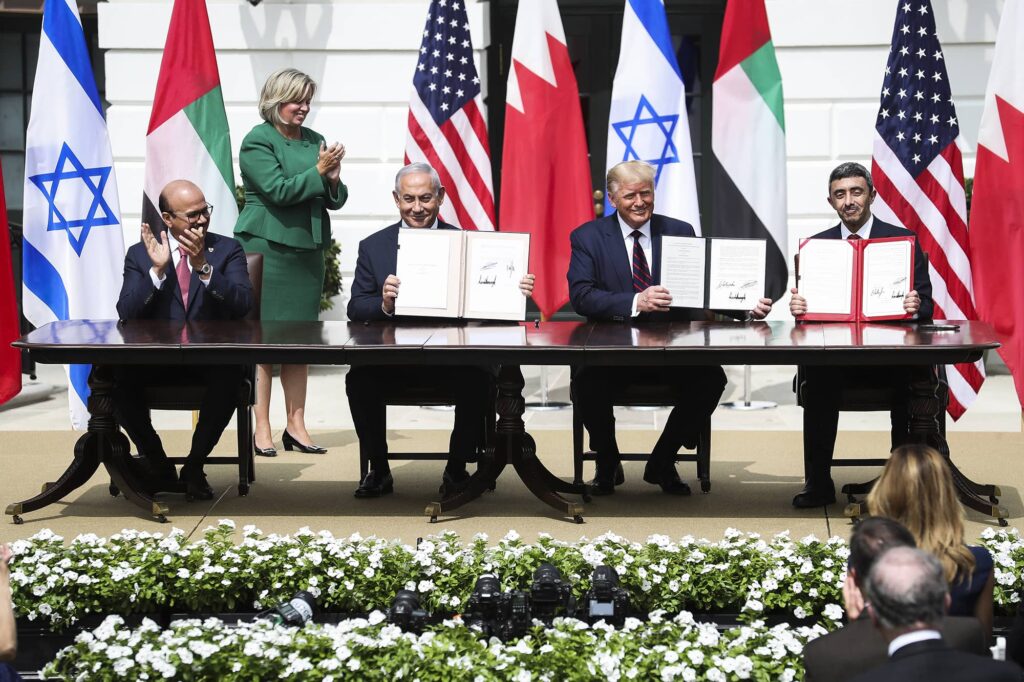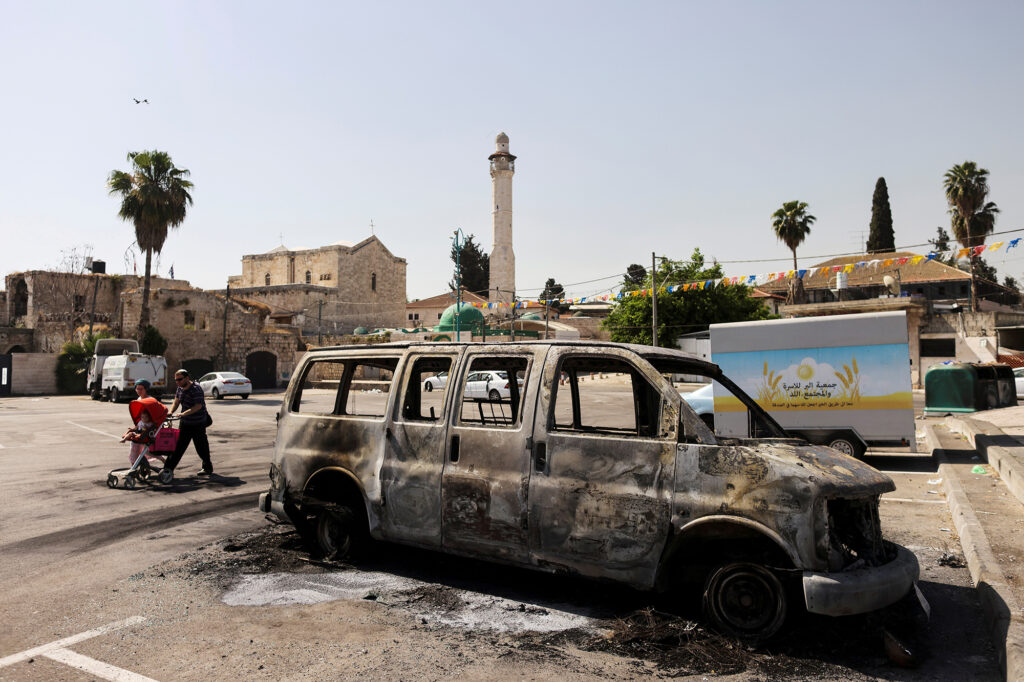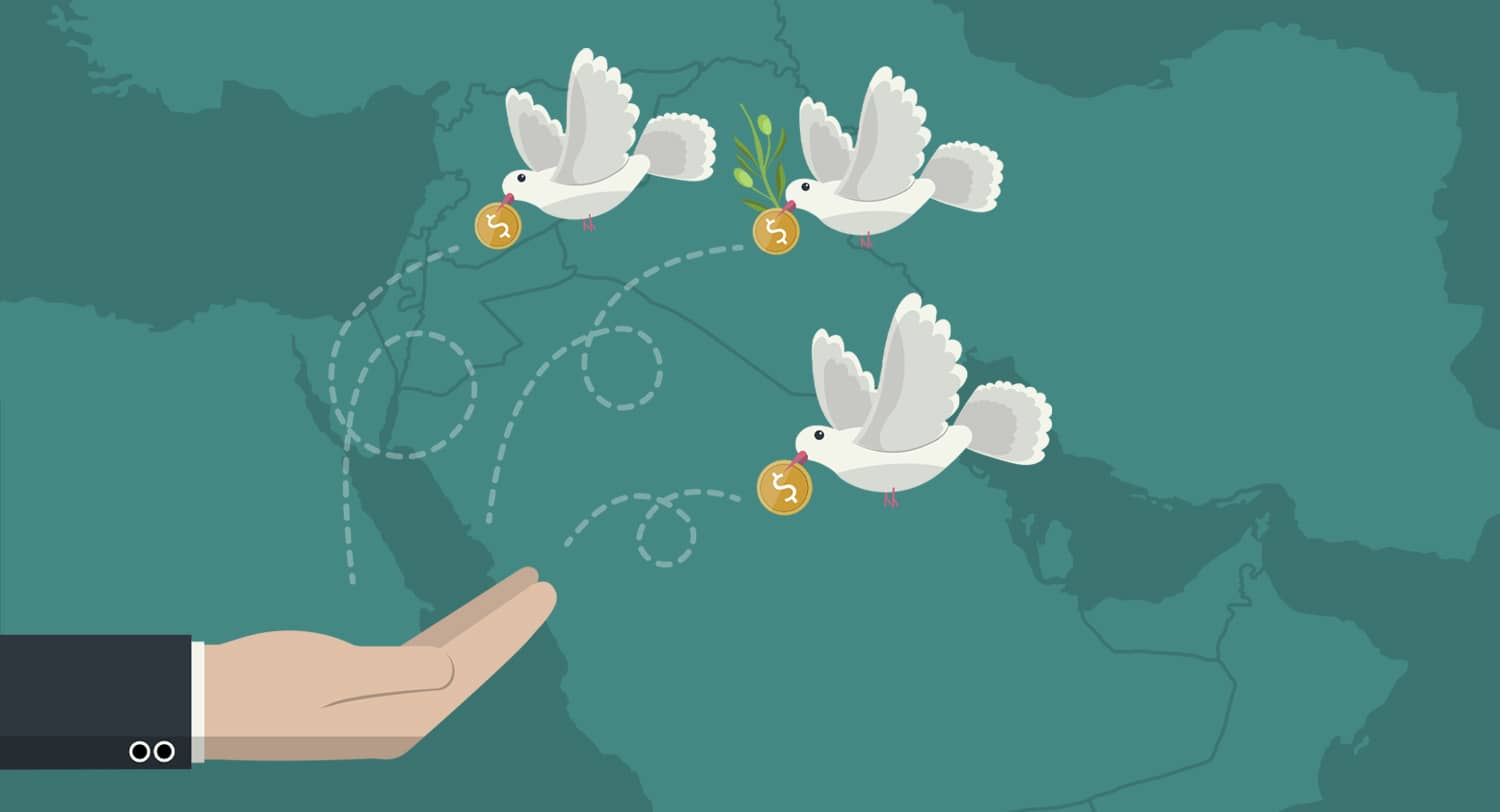On September 26, 2021, Israel’s then Prime Minister Naftali Bennet took the podium at the UN General Assembly and laid out a grand vision for the Middle East. It was a modernist, advanced, technological future (as befitted Bennet, a former high-tech entrepreneur) in which Israel would play a major role – focused upon a world of economic utility rather than identity politics.
Bennet was not the first to have this vision. He echoed the strategy pursued since 2009 by governments led by Binyamin Netanyahu. At its core is the idea of an “economic peace,” a regional experiment in which Israel has been engaged for at least 15 years.
A Vision of Modernism and Prosperity
The roots of “economic peace” date to the early days of the Zionist movement, specifically to Theodore Herzl’s utopian novel Altneuland (“Old-New Land”) published in 1902, in which the pull of modernity is clearly the moving force of his political project.
As Herzl envisioned it, Zionism would bring to the “East” the promise of progress, modernization and development, and fulfill a significant moral duty towards people now degraded by neglect and poverty. Side by side with this moral purpose, he saw this mission as a strategic appeal to the peoples of the region which would induce them to accept the presence of the Jewish national movement. Herzl’s State of the Jews was supposed to be based on a western European, inclusive model, i.e., one that the Arabs of the land could be part of, owing to their own self-interest and the recognition of the benefits the Zionist movement can bring.
Herzl’s vision was followed by other Zionist leaders. In 1919, Chaim Weizmann signed an agreement with Prince Faisal, the son of the Hashemite King of the Hejaz (an agreement left unfulfilled, because the French soon drove the Hashemites out of Syria) which articulated this expectation of economic benefits. David Ben-Gurion and his socialist associates initially posited that Zionist progressive influence could lead to the liberation of the Palestinian Arab serfs from the domination of their landowners, and in return those former serfs would recognize the Jewish right to self-determination. Even Ze’ev Jabotinsky, while warning against such illusions, hoped that “there shall live in peace and prosperity the Son of Arabia, the Son of Nazareth, and mine own Son.” In the early years of the Israeli state, despite the hostilities, the imprint of the economic peace vision lingered, as modernity was again being put on offer as a tool of transforming relations with neighboring Arab states.
Partial Realization of the “Economic Peace”
By the 1990s, Shimon Peres, one of the architects of the Oslo Accords with the PLO, articulated a new version of this concept – a “New Middle East” that was technologically advanced and economically integrated.
But Peres was not to realize this vision. More than any single leader, it was the economic transformation of Israel into an affluent, technologically innovative “Start-Up Nation” that moved the vision forward. There was some support as well among the hopes generated in the Arab countries in the upheavals that began in late 2010 – the “Arab Spring” – which were about the quest both for liberation from repressive autocracies and for redistribution of wealth and reversal of the global patterns of growing inequality. It was under these circumstances that Israel found the opening enabling it to translate Herzl’s ideas of economic benefit into a strategy, utilizing the relative advantages Israel has acquired in recent decades.
Thus in the early years of the decade 2010-2020, It became possible for Israel to link up economy, diplomacy and politics and propose the following to its Arab neighbors: growth, stability and modernization in return for the suppression of Islamist ambitions and the traditional identity politics of the Middle East. Israel re-shaped its relationships with the region in three circles, with a common thread through all: the nearest, with Israel’s Arab citizens; then with the Palestinians in the West Bank and the Gaza Strip; and further afield with the neighbors – Egypt and Jordan – as well as with the Gulf states and Morocco.
With the Arab citizens of Israel, the Netanyahu governments implemented an unprecedented policy of integration into the national economy: significant sums were directed towards narrowing socio-economic gaps, improving infrastructure in Arab communities and promoting higher education. This culminated with the Bennet-Lapid government of 2021-2022, in which political cooperation with the Arab community reached a new level when an Israeli Arab political party joined a governing coalition for the first time in Israel’s history.
Similar policies were applied in the West Bank. Israel generated a pattern of “cooperation amidst a conflict” with Mahmoud Abbas’ Palestinian Authority: the government offered access to the Israeli economy and labor market in return for security cooperation.
Egypt and Jordan were offered benefits of their own – specifically, natural gas and water – while the culmination of the economic peace efforts came with the Abraham Accords of 2020, bringing to light a decade or more of semi-covert cooperation between Israel and some of the Gulf dynasties. The main aspect of these relationships was economic, but there was also a common security interest vis-à-vis the common Iranian threat.

Success and Backlash
This grand strategy, economic and utilitarian, in effect broke the region into two camps: that of the beneficiaries, including those who engineered the new system or shared in it, willingly (such as the Gulf states) or unwillingly (such as the Palestinian Authority in the West Bank); and that of the resistance whose inspiration was the “Old” Middle East as defined by nationalist and Islamist identity politics. In the last two decades the beneficiaries seemed to be gaining ground at the expense of the resistance, so much so that the region seemed to be on the verge of realizing Francis Fukuyama’s global notion of the “End of History.” But this proved to be an illusion.
Israel indeed broadened the scope of its relations in the region, signed new agreements, enjoyed relative security and stability, and in coordination with the Trump administration tried to apply the logic of economic tools even further: pressuring Iran through sanctions to induce it to abandon its nuclear project and take a place in the camp of beneficiaries, offering inducements to the rogue elements in the neighborhood, above all Hamas but also Hizbullah, insofar as the maritime delineation agreement with Lebanon was supposed to give Lebanon hope for gas income, in return for moderating Hizbullah activism.
But while Israel was trying to re-define the Middle East through economic strategies, cracks began to appear. The camp of resistance formulated an alternative vision of the power of identity politics and of the Jewish-Palestinian and Israeli-Arab conflicts. The camp of resistance accentuated the fissures between those who benefited from economic cooperation with Israel (such as the Palestinian Authority elites) and those who felt left behind (including peripheral elements of Israeli Arab society in the mixed Arab-Jewish cities in Israel, who generated riots in May 2021).

The economic peace model generated self-delusional assumptions within the Israeli establishment, which began to see it not only as a tool of conflict management, but as a way of bringing the entire conflict to its end. This delusion, in turn, blurred Israel’s grasp of actual realities on the ground and reduced the investment in the implements of hard power – the military, the police, the security services – which should have been at the ready if the strategy failed.
The rejection by peripheral groups – geographically, sociologically or politically marginalized – sought to break the rules of the game that the utilitarian center tried to impose. This breakdown was joined, gradually, by the Iranians, pro-Iranian militias in Syria and Iraq, and Hizbullah, which began to challenge Israel in the north. Thus a new campaign gained momentum, with repeated “pinpricks” – terror, short rounds of warfare, occasional use of missiles – aimed at undermining the Israeli strategic order.
This new effort reached a crescendo in the assault on October 7, 2023, with a massive rocket attack coupled with the attempted conquest of the border communities and the murder, rape, and abduction of Israelis.
The timing of the Hamas invasion serves as proof that the dismantling of the “economic peace” concept was uppermost in the minds of the resistance camp. It came when efforts to bring about Saudi-Israeli normalization seemed to almost mature – which would have consolidated the Abraham Accords architecture. The assault was deliberately designed to lead to a regression back to the ideological identity politics of the Middle East and the familiar fault lines – Zionists vs. Arabs, Jews vs. Muslims – and bring the Palestinian question, which had seemed to fade from the regional agenda, back to center stage.
Where Can the Economic Vision Go Now?
Eight months into the Gaza war, the resistance has registered a success in challenging the foundations of the new regional order. True, Hamas has been badly mauled but it is not yet defeated. The Iranian attack on Israel on April 14 was defeated, but the US, upon whom the Gulf states rely for their security, failed to deter Tehran from launching it. The logic of common interests – economic and military – is still at work; but overall the region seems to be sliding back to the identity and ideological patterns of the 20th century.
The war undid Israel’s stable security environment and undercuts its economic prowess and technological edge. The Palestinian question is central once again, so that even Israel’s Abraham Accords partners – and the would-be new partner, Saudi Arabia – insist on conditioning the relationship on progress towards a solution, based on the Arab Peace Initiative of 2002. The notions of “arrangements” and even cooperation between rivals have been replaced by stark, classical binary definitions of war versus peace. Even Israeli internal politics, which in his hopeful UN speech Bennet described as an experiment in bringing together left and right, Jews and Arabs, based on the discourse of benefits, have been largely dominated once again by sharp ideological discourse and division.
The region is thus facing a complex reality, in which the “New Middle East” – utilitarian, economic, pragmatic – is severely challenged by the “Old” – ideological, political, totalitarian. This shift of fortunes, paralleled by similar reversals of economic integration elsewhere from Ukraine to Taiwan, will require those who still want to believe in the benefits of peace to adopt, paradoxically, aspects of the rationale of their enemies. This will require a painful adjustment, which for Israel means the abandonment of the illusions of recent decades and a restructuring – military, social, political and ideological – which will enable it to prosecute the regional war which began on October 7 and which is very far from over.

